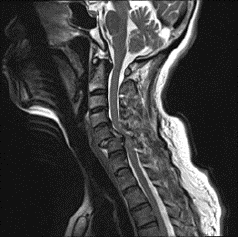Background

The spinal cord is essential to the motor and sensory function of a person’s body. It is very fragile, but well protected.
- The first layer of defense is the cerebrospinal fluid that surrounds the nerves.
- Next, connective tissue surrounds the nerves and the spinal fluid providing another layer of protection.
- And finally, the spinal column – made up of vertebrae – surrounds the cord.
Even with all of this protection, one violent injury can break through these defenses causing severe, and often times, irreparable damage.
A traumatic spinal cord injury, while sudden, does not end with the initial injury. The injury is a process that includes the initial injury, secondary injury and the effects the injury will have on the spinal cord for weeks to months to come.
Initial Injury:
- The spinal injury breaks through the defenses and either completely or partially cuts through the spinal cord, blocking signals from the brain to reach the nerves below the injury.
- Cells begin to die.
- Toxic substances are released that causes more damage.
Secondary Injury – days to weeks after injury:
- As the spine heals, new blood vessels are formed.
- The immune system takes a big hit during a SCI. This can cause general health problems and slow recovery.
- Scar tissue forms.
- The scar tissue freezes and prevents regeneration.
Long-term effects
- Some return of function may be realized, depending on the location and severity of the injury as the nerves find a way to take on new functions.
- Even with the nerves finding new pathways, many patients are left with minimal to no function in their arms and/or legs.
The type of disability which occurs after the spinal cord is injured depends on the severity of the injury and the location of the injured segment of the spinal cord.
SEVERITY OF SCI:
- COMPLETE: A spinal cord injury is considered complete if all feeling (sensory function) and all controlled movement (motor function) are lost below the neurologic level of injury.
- INCOMPLETE: A spinal cord injury is considered incomplete if there is some sensory or motor function below the level of injury. There are varying degrees of incomplete injury.
LOCATION OF INJURED SEGMENT:
- Lumbar spine (lower back): A traumatic injury to the lower back may cause loss of sensory and motor function to the legs. It may also cause sexual dysfunction and bowel and bladder dysfunction.
- Thoracic spine (mid back – area of the spine within the ribcage): A traumatic injury to the thoracic spine will include the disabilities of the lumbar spine. It may also affect the torso up to the level of injury.
- Cervical Spine (neck): An injury in this area will have the most severe disabilities. It will include the disabilites of the lumbar and thoracic injuries, along with loss of sensory and motor function in the arms and hands. It may also affect the ability to breathe without assistance.
Depending on several factors, here are some of the current treatments available:
- Surgery – to stabilize fractured bones and release pressure from injured area.
- Medicine to reduce swelling.
- Drug studies to potentially stop the secondary damage.
- Therapy
- Nerve transfer surgery – 6 months to years post-injury.
- Tendon Transfer surgery – 6 months to years post-injury.